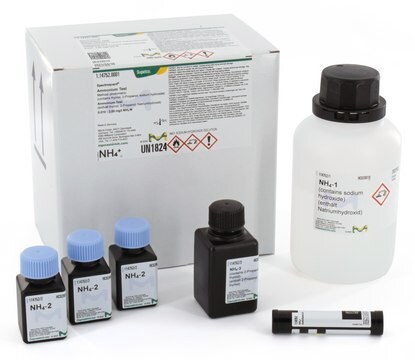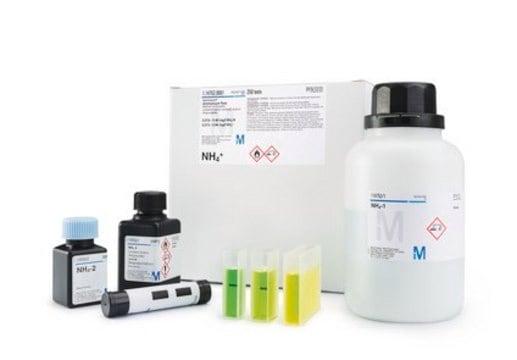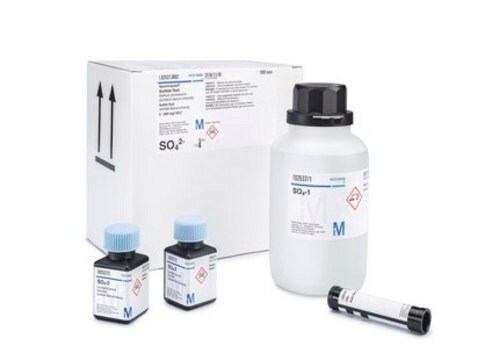1.14897
Chloride Test, photometric
photometric, 2.5-250 mg/L (Cl-), Spectroquant®
About This Item
Polecane produkty
product name
Chloride Test, photometric, 2.5-250 mg/L (Cl-), Spectroquant®
linia produktu
Spectroquant®
Poziom jakości
zastosowanie
sufficient for 100 tests
sufficient for 175 tests (depending on package size)
specyficzne anality
chloride
zakres pomiaru
2.5-250 mg/L (Cl-)
metody
photometry: suitable
kompatybilność
for use with Spectroquant® Move 100
for use with Spectroquant® Nova 60 A
for use with Spectroquant® Prove 100
for use with Spectroquant® Prove 300
for use with Spectroquant® Prove 600
metoda wykrywania
photometric (Iron(III)-thiocyanate)
temp. przechowywania
15-25°C
Opis ogólny
This Spectroquant® Chloride test allows the accurate quantification of chloride ions in various waters and waste water. Their concentration depends on geological factors and the general local situation. Within the test chloride ions react with mercury(II)-thiocyanate to mercury(II) chloride. The liberated thiocyanide reacts with iron ions to form a read complex. The method is analogous to EPA 325.1 and APHA 4500-Cl- E.
All our Cell and Reagent Test Kits are equipped with the unique Live ID (2D barcode) which allows seamless method recognition and contains essential information such as lot number, expiry date, and automatic calibration updates.
The Spectroquant® Reagent Test Kits contain highly stable, ready-to-use reagent mixtures to perform the analysis according to the procedure described in the accompanying instruction leaflet.
Zastosowanie
- PREFUL MRI for Monitoring Perfusion and Ventilation Changes after Elexacaftor-Tezacaftor-Ivacaftor Therapy for Cystic Fibrosis: A Feasibility Study.: This study demonstrates the use of PREFUL MRI to monitor changes in perfusion and ventilation in cystic fibrosis patients post-therapy, showcasing its potential for non-invasive assessment in clinical settings (Dohna et al., 2024).
- Wearable sweat chloride sensors: materials, fabrication and their applications.: Reviews advances in materials and fabrication techniques for wearable sweat chloride sensors, discussing their significant potential for real-time health monitoring and diagnostics (Patel et al., 2024).
- Initial characteristics of cystic fibrosis in Algeria: Description of 34 pediatric cases.: Provides an overview of the clinical presentation and initial characteristics of cystic fibrosis in a pediatric Algerian cohort, contributing to the regional understanding of this genetic disorder (Bendoukha et al., 2024).
Informacje prawne
Hasło ostrzegawcze
Danger
Zwroty wskazujące rodzaj zagrożenia
Zwroty wskazujące środki ostrożności
Klasyfikacja zagrożeń
Acute Tox. 3 Dermal - Acute Tox. 4 Inhalation - Acute Tox. 4 Oral - Aquatic Acute 1 - Aquatic Chronic 1 - Eye Dam. 1 - Met. Corr. 1 - Skin Corr. 1B - STOT RE 2
Kod klasy składowania
6.1A - Combustible, acute toxic Cat. 1 and 2 / very toxic hazardous materials
Klasa zagrożenia wodnego (WGK)
WGK 3
Temperatura zapłonu (°F)
188.6 °F
Temperatura zapłonu (°C)
87 °C
Certyfikaty analizy (CoA)
Poszukaj Certyfikaty analizy (CoA), wpisując numer partii/serii produktów. Numery serii i partii można znaleźć na etykiecie produktu po słowach „seria” lub „partia”.
Masz już ten produkt?
Dokumenty związane z niedawno zakupionymi produktami zostały zamieszczone w Bibliotece dokumentów.
Klienci oglądali również te produkty
Protokoły
Photometric determination using the iron(III)/mercury thiocyanate method after fusion melting
Powiązane treści
Czysta woda pitna jest niezbędna do produkcji żywności i napojów. Niniejszy artykuł zawiera przegląd chemicznych i mikrobiologicznych testów wody pitnej pod kątem jakości i bezpieczeństwa.
Czysta woda pitna jest niezbędna do produkcji żywności i napojów. Niniejszy artykuł zawiera przegląd chemicznych i mikrobiologicznych testów wody pitnej pod kątem jakości i bezpieczeństwa.
Clean drinking water is essential for food and beverage production. This article gives an overview of chemical and microbiological testing of the drinking water for quality and safety.
Nasz zespół naukowców ma doświadczenie we wszystkich obszarach badań, w tym w naukach przyrodniczych, materiałoznawstwie, syntezie chemicznej, chromatografii, analityce i wielu innych dziedzinach.
Skontaktuj się z zespołem ds. pomocy technicznej








